user manual
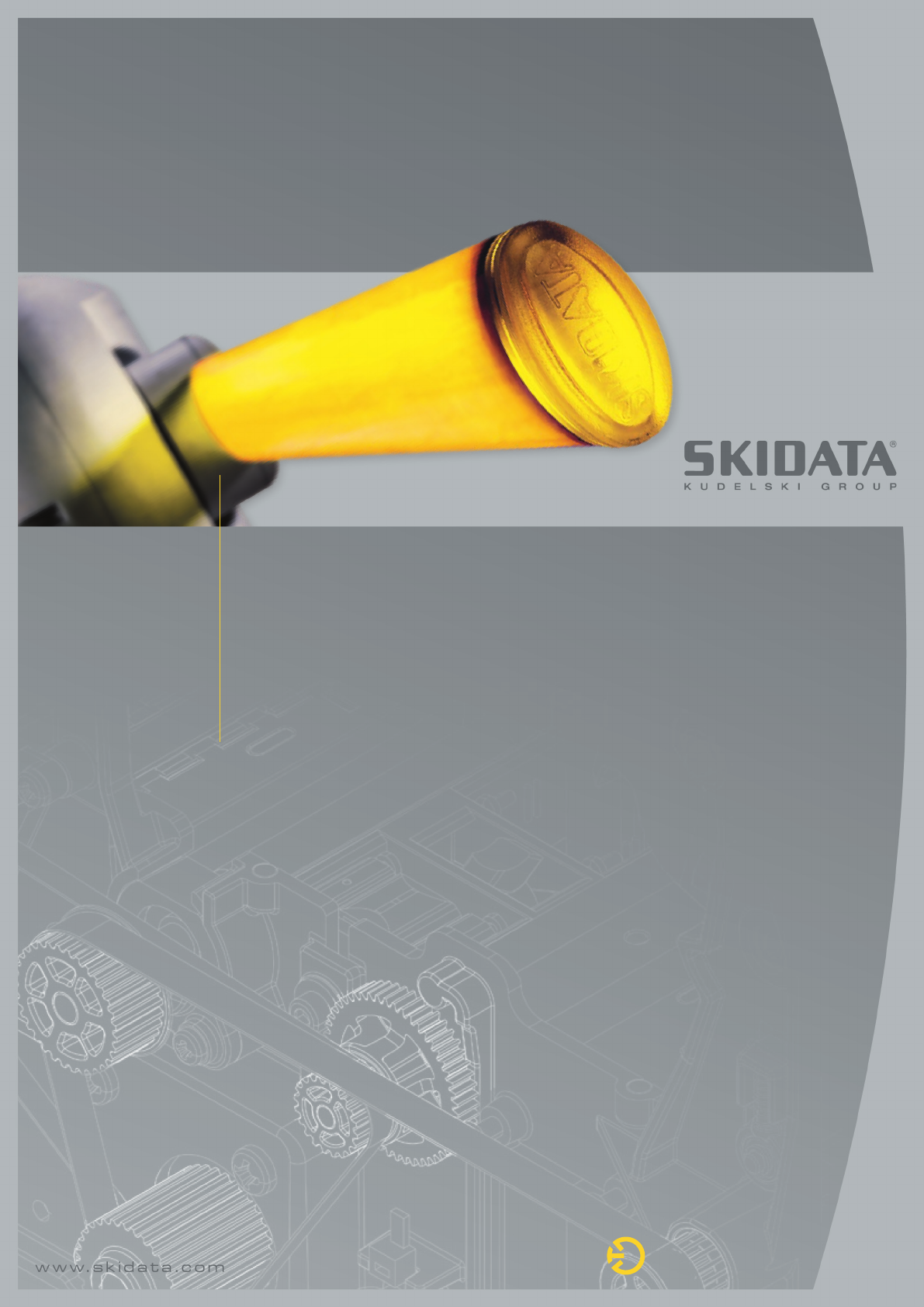
Keydetector.Gate
‘wall/desk’
Car Access
Instructions for Installation V1.1
Documentation
& Tr aining

Keydetector.Gate ‘wall/desk’ - CA
Page 2 © SKIDATA AG, Instructions for Installation V1.1
Instructions for Installation – Keydetector.Gate ‘wall/desk’
June 2011 Edition
SKIDATA AG
Documentation & Training
Untersbergstrasse 40
A-5083 Groedig/Salzburg
Tel.: +43 6246 888-0
Fax: +43 6246 888-7
Internet: http://www.skidata.com
E-mail: docu@skidata.com
Copyright
© 2011 by SKIDATA AG. All rights reserved. The information provided in this document is
protected by copyright law. No part of this documentation may be copied or reproduced without the
prior written consent of SKIDATA AG. SKIDATA AG reserves the right to make changes to the
specifications and other information contained in this documentation without prior notice.
Note
Great care has been taken to make the information contained in this documentation as correct and
accurate as possible. Although this documentation is updated regularly, SKIDATA AG cannot
guarantee the absolute correctness and completeness of the information contained herein.
Trademarks
This documentation may contain representations of registered product or service trademarks
owned by SKIDATA AG or third parties, as well as references to proprietary know-how protected by
copyright laws or other legal provisions. In any case all rights remain exclusively with their
respective owners.
SKIDATA® is a registered trademark of SKIDATA AG in the USA, the European Union and other
countries.
EU Directives
All devices mentioned in this document were designed and manufactured in compliance with one
or more of the following EU Directives:
Machinery Directive 98/37/EC
Machinery Directive 2006/42/EC
EMC Directive 89/336/EEC, as amended by 91/263/EEC, 92/31/EEC, 93/68/EEC
EMC Directive 2004/108/EC
Low Voltage Directive 73/23/EEC, as amended by 93/68/EEC
Low
Voltage Directive 2006/95/EC
R&TTE Directive 1999/5/EC
The following regulations apply expressly to all UL certified devices:
If a device is
retroactively converted, upgraded or otherwise modified, this automatically voids any
existing UL certification
of that device. UL certifications apply only to devices in their original
condition that have been properly installed in accordance with the appropriate installation
instructions and applicable local regulations.
To retain UL certification of a retroacti
vely modified device, an "On-Site Certification" must be
obtained from Underwriters Laboratories Inc. (UL) by and at the expense of the device operator.

Keydetector.Gate ‘wall/desk’ - CA Table of Contents
© SKIDATA AG, Instructions for Installation V1.1 Page 3
Table of Contents
1 About this documentation __________________________________________ 4
1.1 Print layout ______________________________________________________________ 4
1.2 Dimensioning ____________________________________________________________ 4
1.3 Symbols ________________________________________________________________ 4
2 Safety Instructions ________________________________________________ 6
2.1 Risk of electric shock _____________________________________________________ 6
2.2 Electrostatic Discharge (ESD) ______________________________________________ 6
2.3 Warranty and liability _____________________________________________________ 7
2.4 Electromagnetic Compatibility (EMC) ________________________________________ 7
2.5 FCC Statement according to 15.19 __________________________________________ 7
2.6 FCC Note according to 15.21 _______________________________________________ 7
3 Technical Specifications ___________________________________________9
3.1 Keydetector _____________________________________________________________9
3.2 Dimensions Keydetector.Gate ______________________________________________10
4 Installation ______________________________________________________ 11
4.1 Desk-Mounting the Keydetector ___________________________________________ 11
4.2 Wall-Mounting the Keydetector with sd582 __________________________________ 15
4.2.1 Connecting to interface control card sd582 ___________________________________________ 16
5 Integration into the system ('desk’ version) ___________________________ 17
6 Door- / Gate Opener ______________________________________________ 18
6.1 Card Verification Procedure of the Door Opener ______________________________20
6.1.1 Contactless Parking Products (keycard, Swatch Access)_________________________________ 20
6.1.2 Magnetic Strip Cards and Barcode Cards with Access Code ______________________________ 20
6.2 Card Verification Procedure of the Door Opener ______________________________20
6.2.1 Contactless Parking Products (keycard, Swatch Access)_________________________________ 20
6.2.2 Magnetic Strip Cards and Barcode Cards with Access Code ______________________________ 21
6.3 Operational States _______________________________________________________ 21
6.3.1 IDLE State (Door Opener Only) ____________________________________________________ 21
6.3.2 Normal State ___________________________________________________________________ 21
6.3.3 Out of Order ___________________________________________________________________ 21
6.4 Keypad ________________________________________________________________ 22
6.5 Data Exchange with Control Centre Program (CTC) ___________________________ 22
6.5.1 Door- / Gate Opener _____________________________________________________________ 22
6.5.2 Keep Open ____________________________________________________________________ 22
6.5.3 Keep Closed ___________________________________________________________________ 22
6.5.4 Transaction NEUTRAL ___________________________________________________________ 22
6.5.5 Display of Reason for Rejection ____________________________________________________ 22
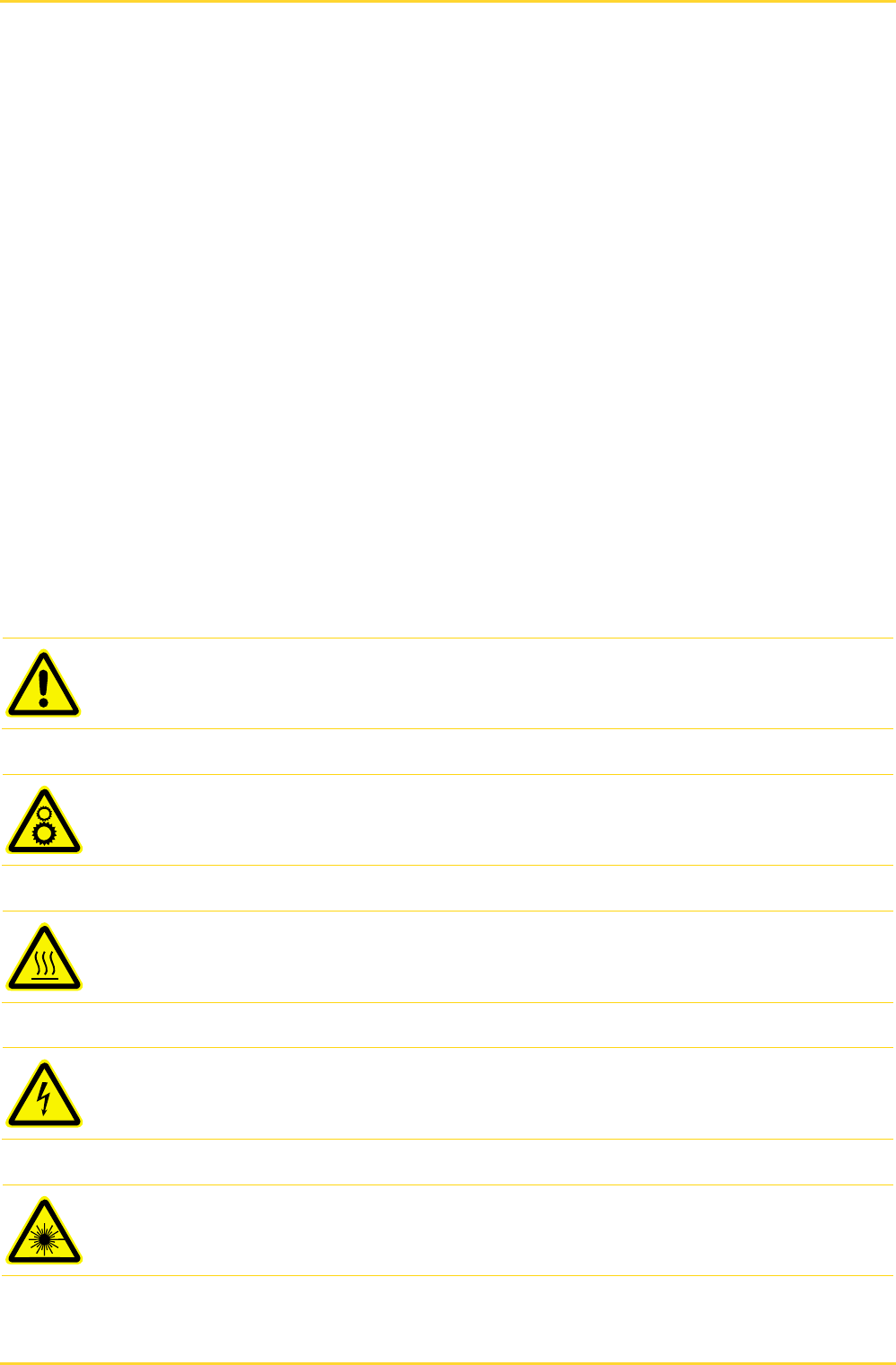
1 About this documentation Keydetector.Gate ‘wall/desk’ - CA
Page 4 © SKIDATA AG, Instructions for Installation V1.1
1 About this documentation
This documentation contains step-by-step instructions for selected procedures required for the
Keydetector.Gate ‘wall/desk’. It does not claim to be complete.
The procedures described in this manual do not include troubleshooting. In case of problems,
please send an accurate problem description to SKIDATA AG Customer Service.
1.1 Print layout
For optimum printing, set your printer to Color and Double-Sided Printing.
1.2 Dimensioning
Dimensions in this documentation are always specified in mm. In cases where other dimension
units are used, they are clearly indicated and specified separately.
1.3 Symbols
Important text passages and notes are marked by symbols and special typefaces throughout this
Manual.
The following symbols are used:
Danger:
Risk of injury.
Danger:
Risk of injury by rotating parts. Do not touch any of these parts while the unit is running.
Danger:
Risk of injury caused by heat. Do not touch any of these parts while the unit is running.
Wait until they have cooled down before touching them.
Danger:
Risk of electric shock. Do not touch these parts unless the power supply of the device
has been di
sconnected.
Danger:
Risk of radiation. Never point the laser at your or other person's eyes, whether directly or
indirectly (by reflection). Laser radiation can cause irreparable eye damage.

Keydetector.Gate ‘wall/desk’ - CA 1 About this documentation
© SKIDATA AG, Instructions for Installation V1.1 Page 5
Danger:
Possible health risks from electromagnetic field. This applies to persons wearing
pacemakers or other active or passive medical devices.
Warning:
Electrostatically sensitive parts. Be sure to discharge any static electricity (e.g. by
grounding yoursel
f to a metal object or wearing an ESD wristband) before touching the device.
This is to avoid possible ESD damage.
Notice:
Warns against actions that might cause hardware and/or software damage.
Hint:
Provides explanations on the proper use of the device or software.
Example:
Describes practical applications to illustrate features, functions, etc.
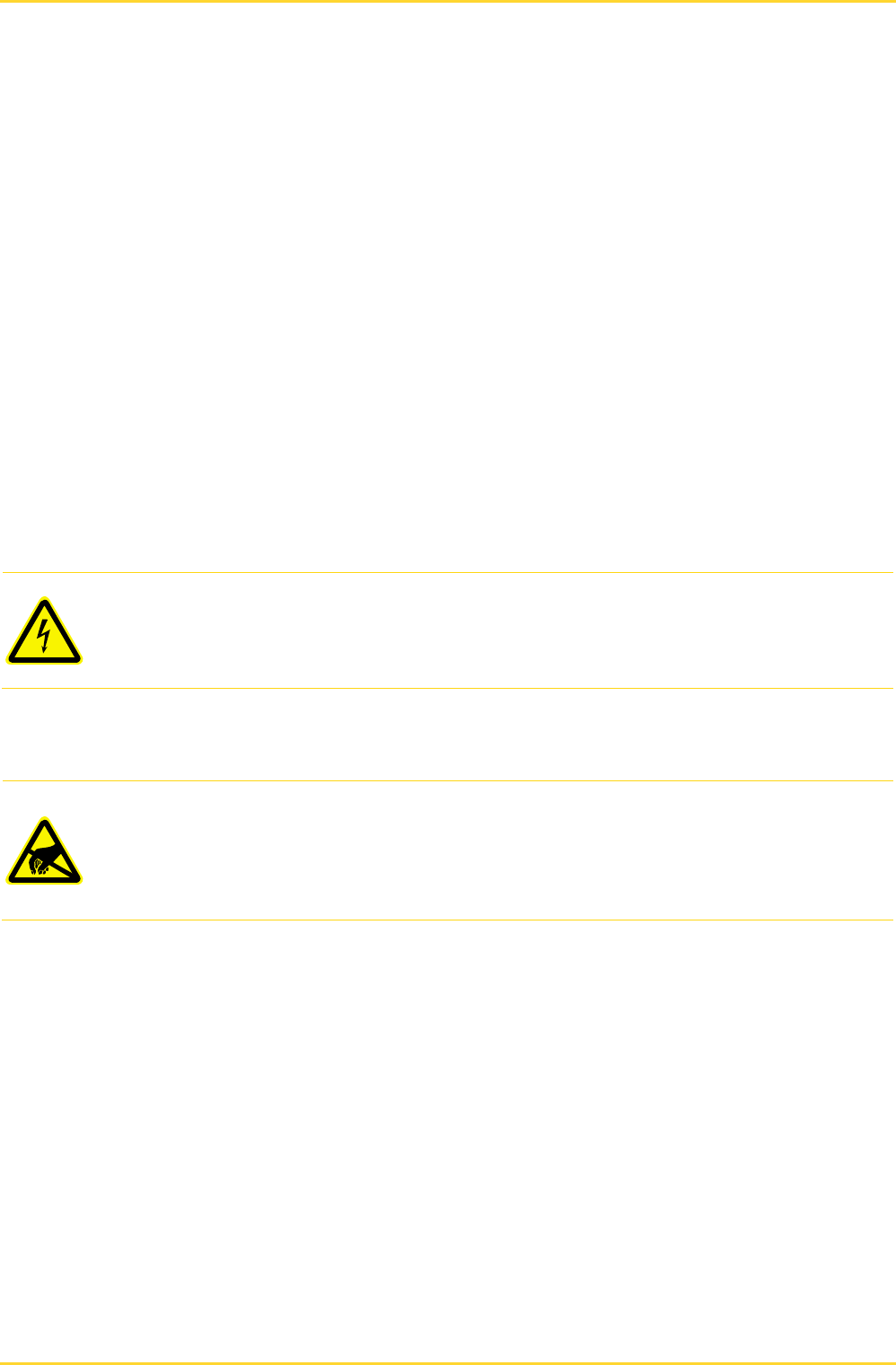
2 Safety Instructions Keydetector.Gate ‘wall/desk’ - CA
Page 6 © SKIDATA AG, Instructions for Installation V1.1
2 Safety Instructions
Keydetector.Gate ‘wall/desk’ has been tested for safety. Operating personnel will be advised of
possible residual danger during system training courses and by the information provided in this
manual.
System units may be used only for their intended purpose, as specified by the manufacturer.
Unauthorized modifications of the units, as well as the use of replacement parts and/or add-on
devices not approved by the manufacturer may lead to electric shock or cause other serious
bodily harm and will void the manufacturer's warranty.
The setup, installation, maintenance and configuration of the system units is limited to certified
electricians with special training in the prevention of accidents.
The technician or project manager responsible is to ensure that the unit is installed and
configured in compliance with local technical guidelines as well as other applicable local
regulations. Relevant parameters include (among others) cable dimensions, protection against
risks, earthing, deactivation, disconnection, insulation testing and over current protection.
2.1 Risk of electric shock
Electrical repair work must be carried out by a professional electrician.
Danger:
Electric installation and maintenance work may be carried out only by appropriately
qualified, licensed electricians. Mains connections must be hard
-wired. Please ensure full
compliance with all applicable national and international rules and regulations
concerning electric
connections, as well as all applicable safety rules.
2.2 Electrostatic Discharge (ESD)
Warning:
Electrostatic Discharge (ESD) energy can harm electronic components. Under certain
conditions, ESD may build up on your body or an object (
e.g., a peripheral device) and then
discharge into another object. Be sure to discharge any static electricity (e.g. by grounding
yourself to a metal object or wearing an ESD wristband) before touching the device. This is to
avoid possible damage from ESD.

Keydetector.Gate ‘wall/desk’ - CA 2 Safety Instructions
© SKIDATA AG, Instructions for Installation V1.1 Page 7
2.3 Warranty and liability
Except for all stipulated warranty and liability regulations, all warranty and liability claims shall be
excluded, in particular if the harm or damage should be attributed to one or more of these
instances:
Misapplication (i.e., non-intended use) of the devices
Improper installation
Inadequate or missing warning and/or safety facilities in the danger area
Irregular or insufficient maintenance
Use of material not approved by SKIDATA AG
Insufficient constructional renovation measures
Insufficient training of operating personnel
Unauthorized constructional, technical or other modifications of the system; Modifications and/or
extensions of the system without the approval or explicit consent of SKIDATAAG
Disaster situations brought about by impact of foreign bodies or acts of God
2.4 Electromagnetic Compatibility (EMC)
Compliance with Electromagnetic Compatibility must be maintained during operation. This requires
that:
Specified maximum lengths of network lines are not exceeded
Network connections are properly installed and maintained
Network cable screens are properly installed and maintained
All system devices and facility installations that are subject to EMC regulations are inspected
regularly and repaired if required
2.5 FCC Statement according to 15.19
This device complies with Part 15 of the FCC rules. Operation is subject to the following two
conditions: (1) This device may not cause harmful interference, and (2) this device must accept any
interference received, including interference that may cause undesired operation.
2.6 FCC Note according to 15.21
Any changes or modifications not expressly approved by the party responsible for compliance
could void the user’s authority to operate the equipment.

2.7 FCC Statement according to 15.105
Note: This equipment has been tested and found to comply with the limits for a Class B digital
device, pursuant to part 15 of the FCC Rules. These limits are designed to provide reasonable
protection against harmful interference in a residential installation. This equipment generates,
uses and can radiate radio frequency energy and, if not installed and used in accordance with
the instructions, may cause harmful interference to radio communications. However, there is
no guarantee that interference will not occur in a particular installation. If this equipment does
cause harmful interference to radio or television reception, which can be determined by turning
the equipment off and on, the user is encouraged to try to correct the interference by one or
more of the following measures:
—Reorient or relocate the receiving antenna.
—Increase the separation between the equipment and receiver.
—Connect the equipment into an outlet on a circuit different from that to which the receiver is
connected.
—Consult the dealer or an experienced radio/TV technician for help.
2.8 Compliance Information Statement
(Declaration of Conformity Procedure)
Responsible Party: SKIDATA, Inc.
Address: 1209 W. North Carrier Parkway – Suite # 301
Grand Prairie, Texas 75050, USA
Telephone: +1 (214) 204-1140 x207
Type of Equipment: RFID Reader
Model
FCC
2.9 Canada Statement according to CNR-Gen Section 7.1.3
This device complies with Industry Canada licence-exempt RSS standard(s). Operation is
subject to the following two conditions:(1) this device may not cause interference, and (2) this
device must accept any interference, including interference that may cause undesired
operation of the device.
Le présent appareil est conforme aux CNR d'Industrie Canada applicables aux appareils radio
exempts de licence. L'exploitation est autorisée aux deux conditions suivantes : (1) l'appareil
ne doit pas produire de brouillage, et (2) l'utilisateur de l'appareil doit accepter tout brouillage
radioélectrique subi, même si le brouillage est susceptible d'en compromettre le
fonctionnement.
2.10 Canada Statement according to ICES-003 resp. NMB-003
This Class B digital apparatus complies with Canadian ICES-003.
Cet appareil numérique de la classe B est conforme à la norme NMB-003 du Canada.

3 Technical Specifications Keydetector.Gate ‘wall/desk’ - CA
Page 9 © SKIDATA AG, Instructions for Installation V1.1
3 Technical Specifications
3.1 Keydetector
Port: USB / SIO
Supply Voltage: USB / SIO +5 V DC ± 5%
Power Consumption: 2.5 W
Scanning Range: keyard: approx. 80 mm (3.150")
Reading Reaction Time: 0.2 secs
Operating Temperature: +20 °C to +60 °C (-4 °F to +140 °F)
Protection class: IP 44
Mounting: As desktop version or in standard Ø 65 mm (2.559") wall
socket
Distance to metal objects: min. 5 cm (1.969")
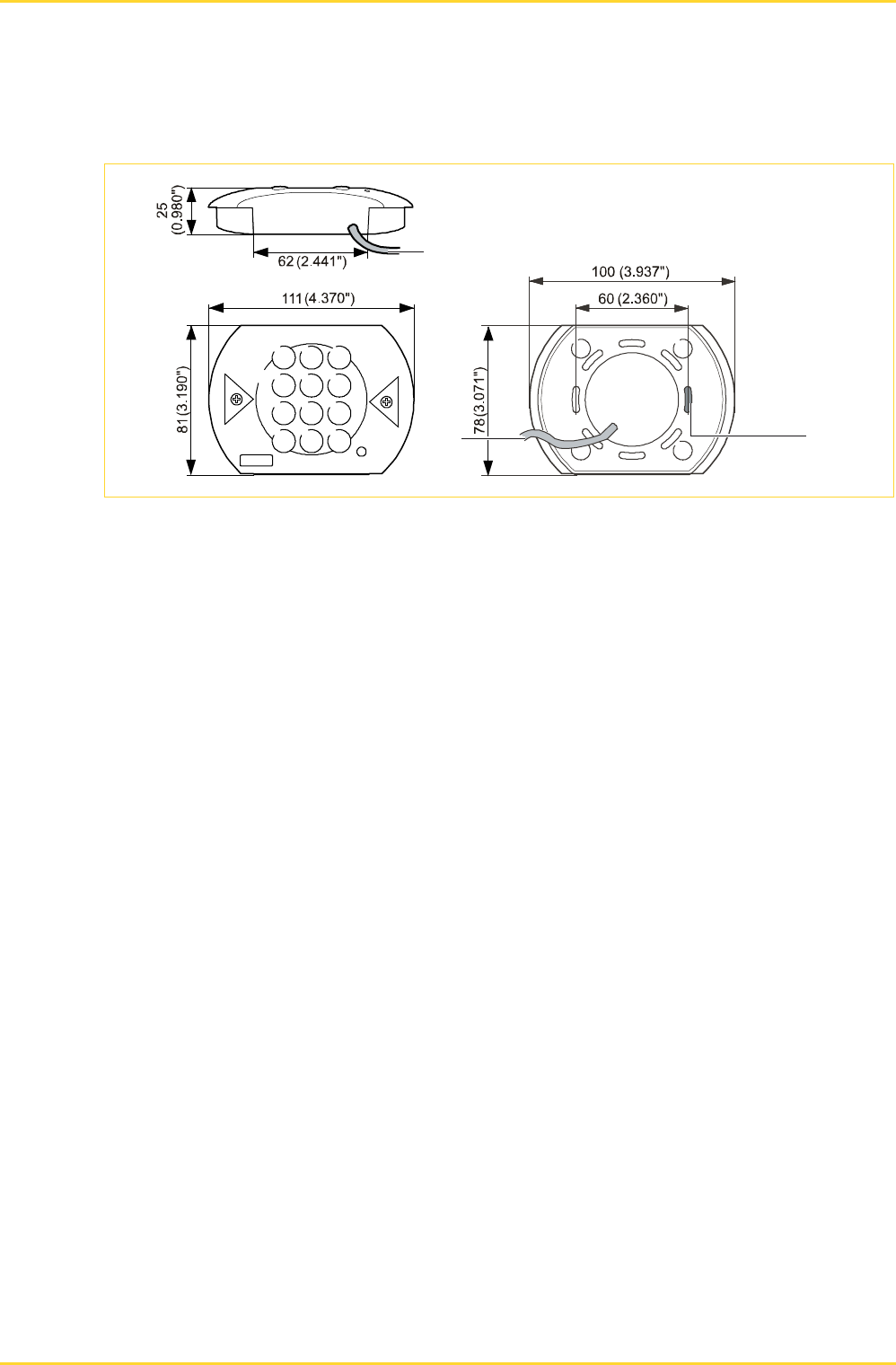
Keydetector.Gate ‘wall/desk’ - CA 3 Technical Specifications
© SKIDATA AG, Instructions for Installation V1.1 Page 10
3.2 Dimensions Keydetector.Gate
Fig.
1: Dimensions Keydetector.Gate
Desktop version (cable length 3 m / 9.8 ft)
Cable
Break out for mounting on standard wall
socket Ø 65 mm (2.559")
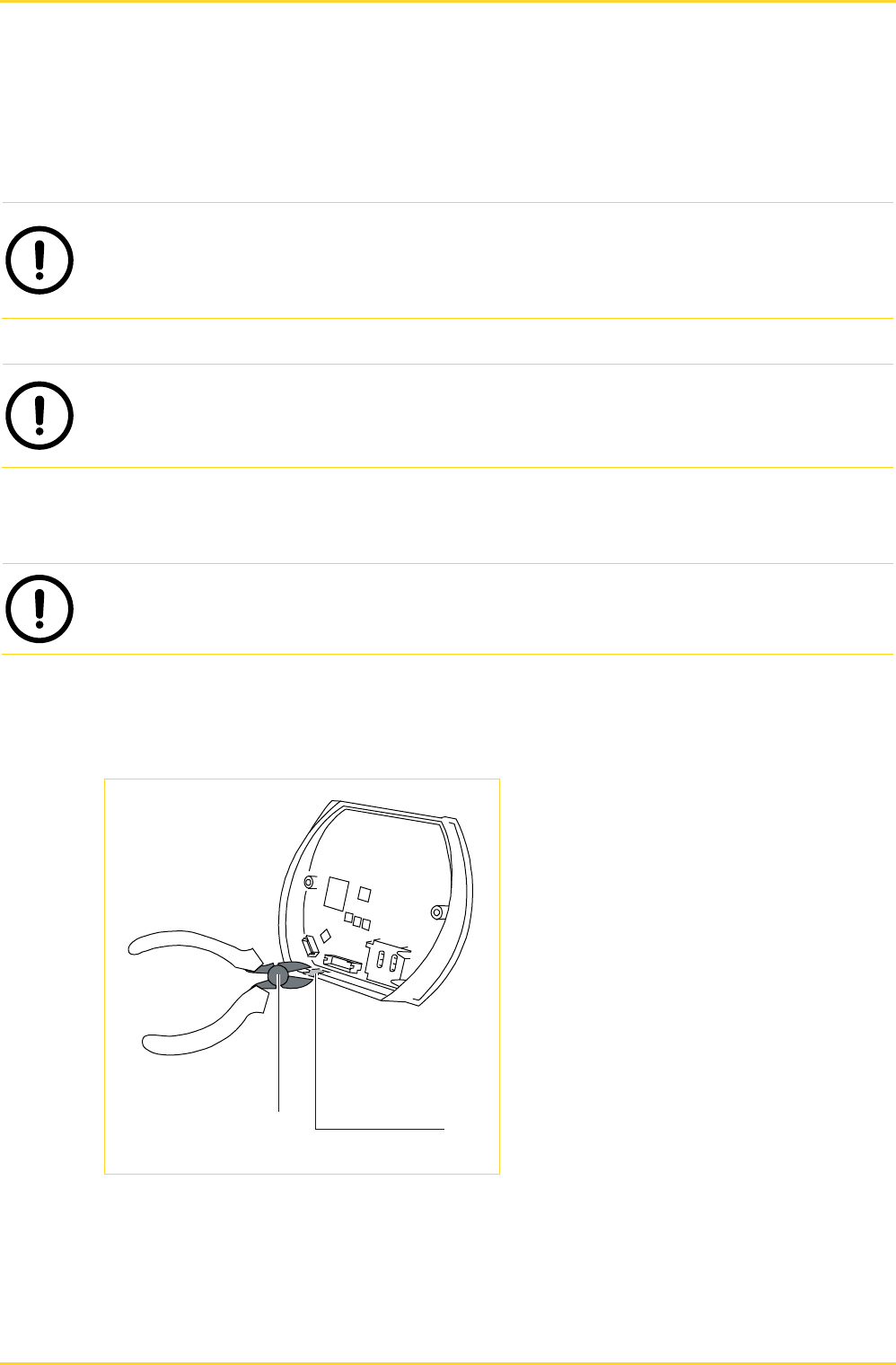
4 Installation Keydetector.Gate ‘wall/desk’ - CA
Page 11 © SKIDATA AG, Instructions for Installation V1.1
4 Installation
The Keydetector can be used as desktop version or mounted in a concealed wall socket for solid or
hollow walls, or surface-mounted next to the door.
Notice
: In configurations supporting contactless access control technologies, avoid mounting the
Door
- / Gate Opener on a metallic surface, as this will reduce the scanning range (i.e. card/watch
reading
distance) of the unit considerably. When mounting the Door- / Gate Opener, a minimum
dis
tance of 5 cm (1.969") from metal objects must be maintained.
Notice:
The control of inductive loads requires the use of a transzorb diode in reverse direction.
Several Door Opener models are fitted with this diode by
default.
Verify that your Door Opener model is fitted with this diode (type: clamping diode 1N4007).
4.1 Desk-Mounting the Keydetector
Notice:
The Keydetector comes factory pre-configured for wall mounting. Using the Keydetector
as a desktop device requires some modifications.
Remove break-off tab
F
ig. 2: Removing break-off tab
Cutting device (e.g. side cutting pliers)
Break-off tab
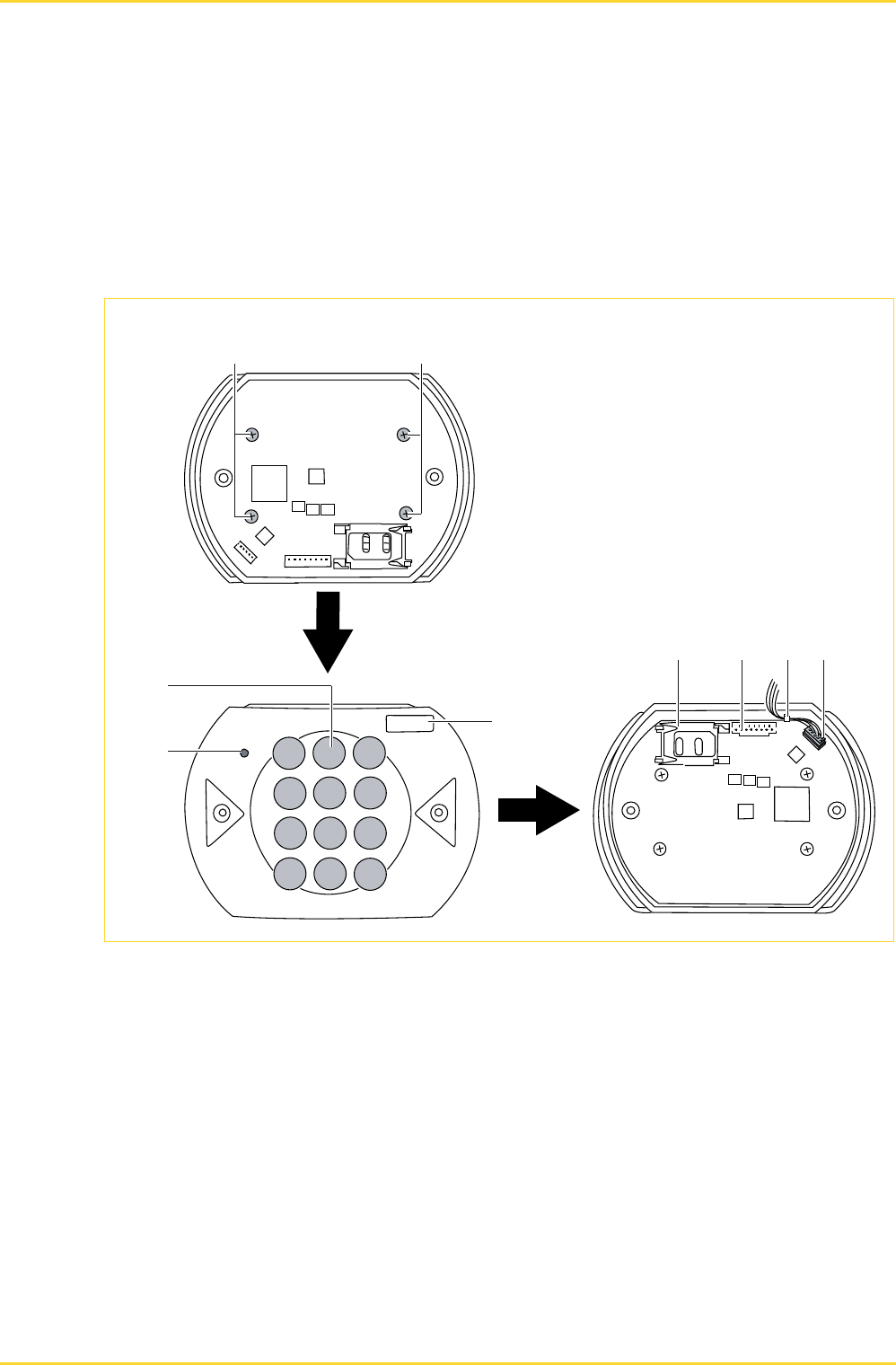
Keydetector.Gate ‘wall/desk’ - CA 4 Installation
© SKIDATA AG, Instructions for Installation V1.1 Page 12
Unfasten locking screws on the control board (PCB)
Take out the sd804 board
Take out the keypad, rotate it by 180° and reinsert it (the 1 key should now be next to the LED)
Attach the SKIDATA label
Screw the sd804 board into place
Plug in the the USB connector and guide the cable through the hole where you removed the
break-off tab
Fig
. 3: Unfastening screws, rotating keyboard, attaching label, plugging in USB connector
Locking screws
Keypad
LED
SKIDATA label
SAM module
I/O connector
Cable ties for strain relief
USB-connector
123
456
789
0E
C
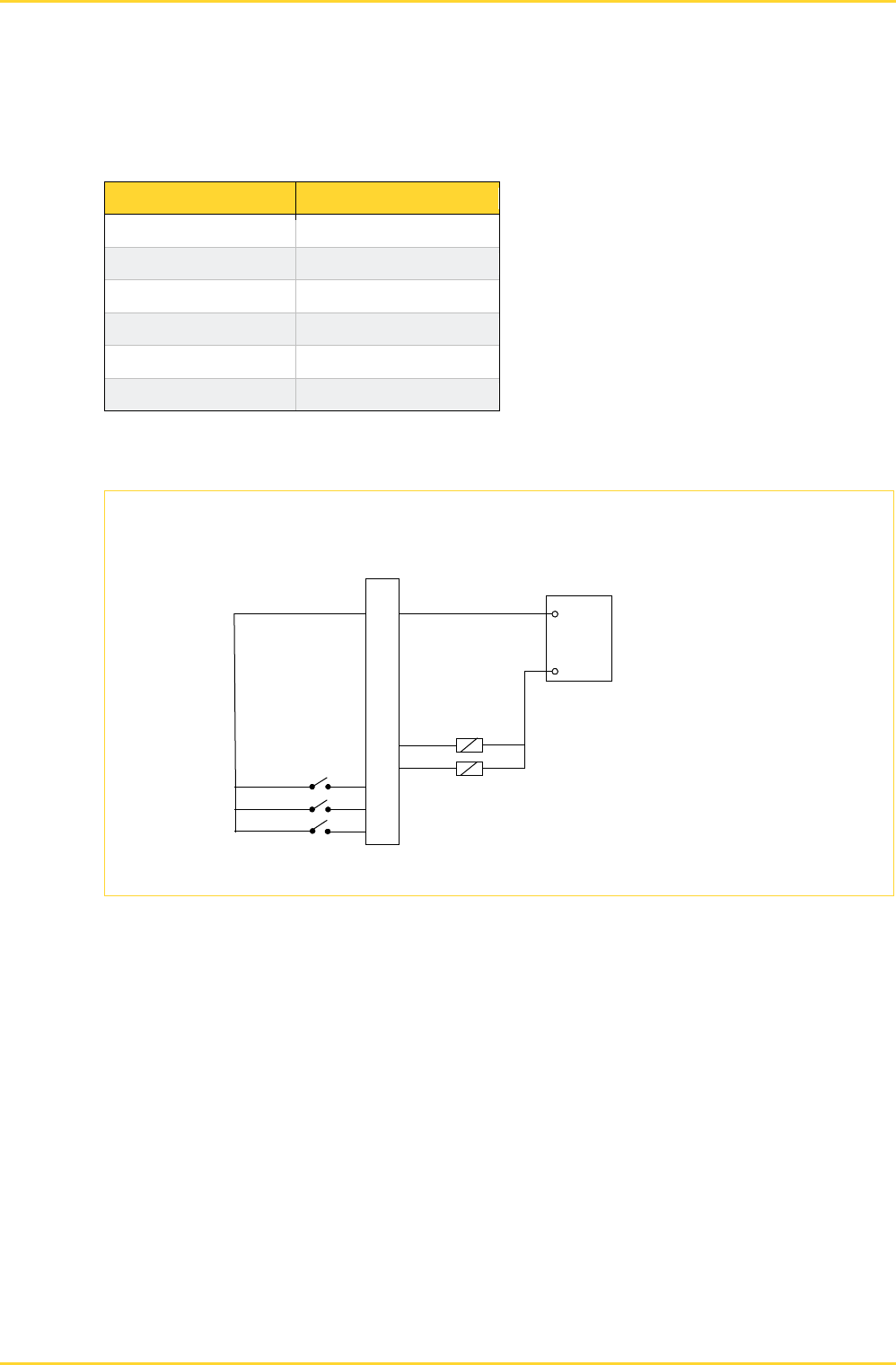
4 Installation Keydetector.Gate ‘wall/desk’ - CA
Page 13 © SKIDATA AG, Instructions for Installation V1.1
If required, connect the I/O cable and use external relays to eliminate any electrical charge.
(Open Collector)
Tab.
1: Connections I/O cable
Pin
Designation / Color
Pin 2
GND (black)
Pin 8
OUT1 (brown)
Pin 9
OUT2 (red)
Pin 10
IN1 (orange)
Pin 11
IN2 (yellow)
Pin 12
IN3 (green)
Fig
. 4: Connections I/O cable
1
2
3
4
5
6
7
8
9
10
11
12
GND GND
max. 0,7 A !
Ext. Netzteil /
power supply
max.
+28 V DC
X5 (sd804)
INPUTS OUTPUTS
OUT1
OUT2
IN1
IN3
IN2
Ausgang ist kurzschlussfest /
Output short-circuit protected

Keydetector.Gate ‘wall/desk’ - CA 4 Installation
© SKIDATA AG, Instructions for Installation V1.1 Page 14
Close the casing and fasten the screws.
Attach the arrow labels (default: yellow/gray, on demand: white/gray)
Fig
. 5: Phillips screws, arrow labels
Phillips screws
Arrow labels
Perform a functionality test: power on the device (plug into USB port on PC):the status LED
should light up red.
123
4 5 6
78 9
C 0 E
123
4 5 6
7 8 9
C0 E
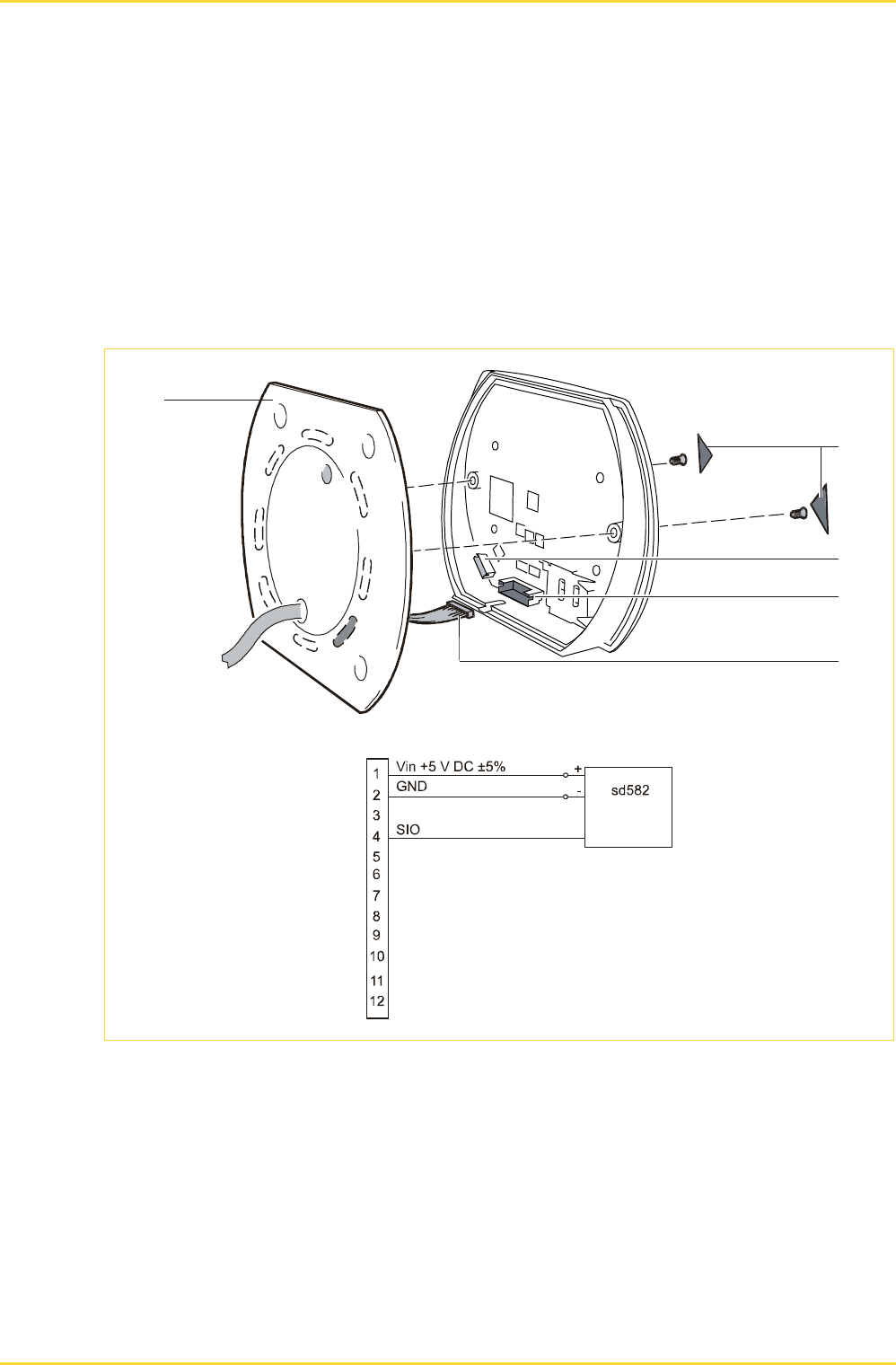
4 Installation Keydetector.Gate ‘wall/desk’ - CA
Page 15 © SKIDATA AG, Instructions for Installation V1.1
4.2 Wall-Mounting the Keydetector with sd582
Fix Skidata logo.
Connect the Keydetector as illustrated.
Fasten the rear wall onto the concealed outlet.
Plug in SIO cable (3 m / 9.8 ft) (=power supply and data line from external controller)
Place the housing on the Keydetector and tighten the fastening screws.
Attach the enclosed masking stickers (Standard: yellow/grey; optional: white/grey).
Switch on the unit to verify that the power supply LED is red.
Fig.
6: Wall installation, Connections sd804
Rear panel Keydetector
Fastening screws, Masking stickers
USB connector
Connector power supply, data signals (SIO)
SIO cable (3m / 9.8ft)
X5 (sd804)
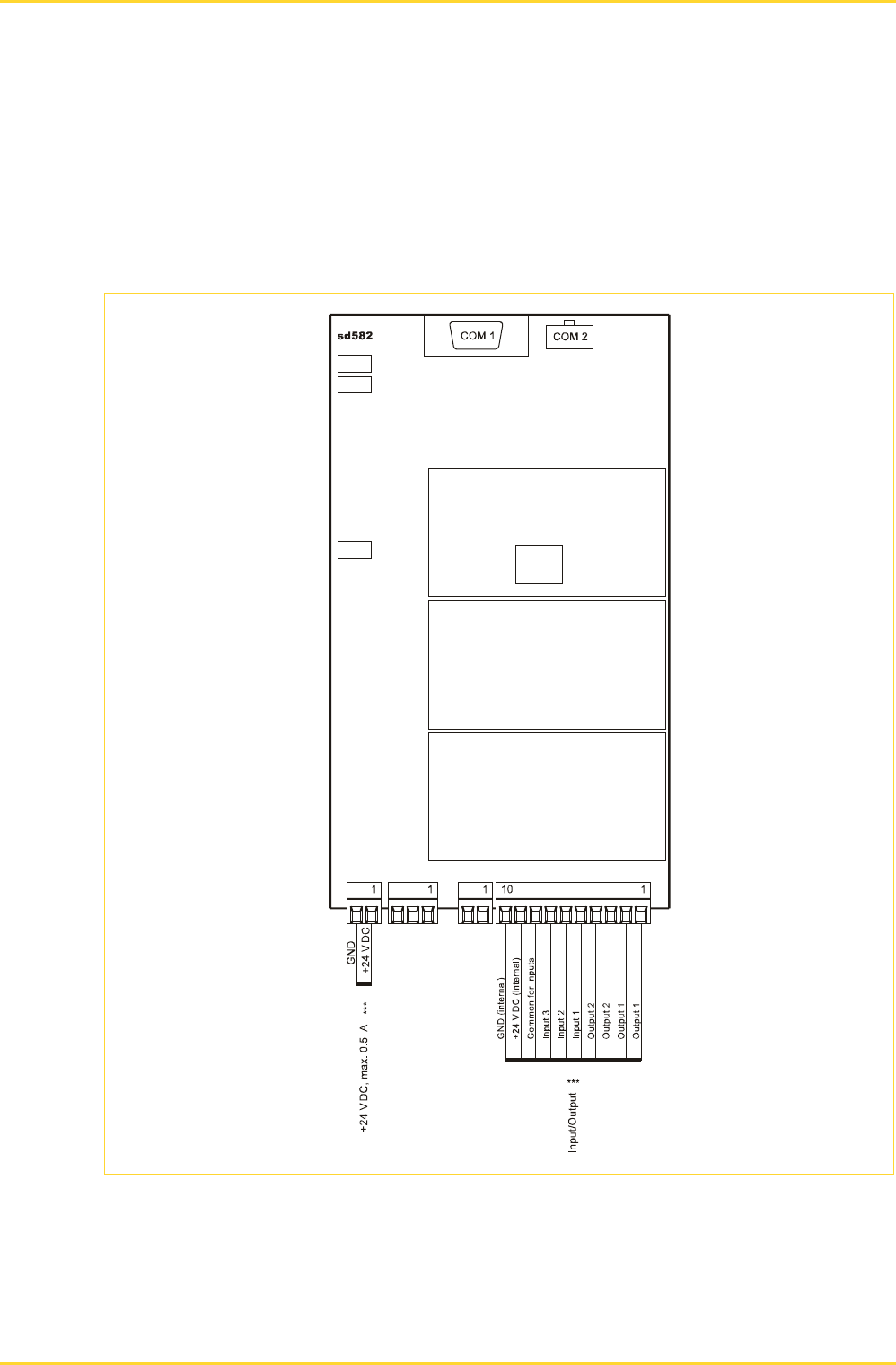
Keydetector.Gate ‘wall/desk’ - CA 4 Installation
© SKIDATA AG, Instructions for Installation V1.1 Page 16
4.2.1 Connecting to interface control card sd582
Set up the cable connection to the Keydetector by means of the SIO cable (Internal SIO
connector - see illustration)
sd582 requires +24 V DC power supply
Plug in Ethernet cable
Connect door opener via I/Os
Fig.
7: Connections sd582
Ethernet
plug-in board
Internal SIO
Internal SIO
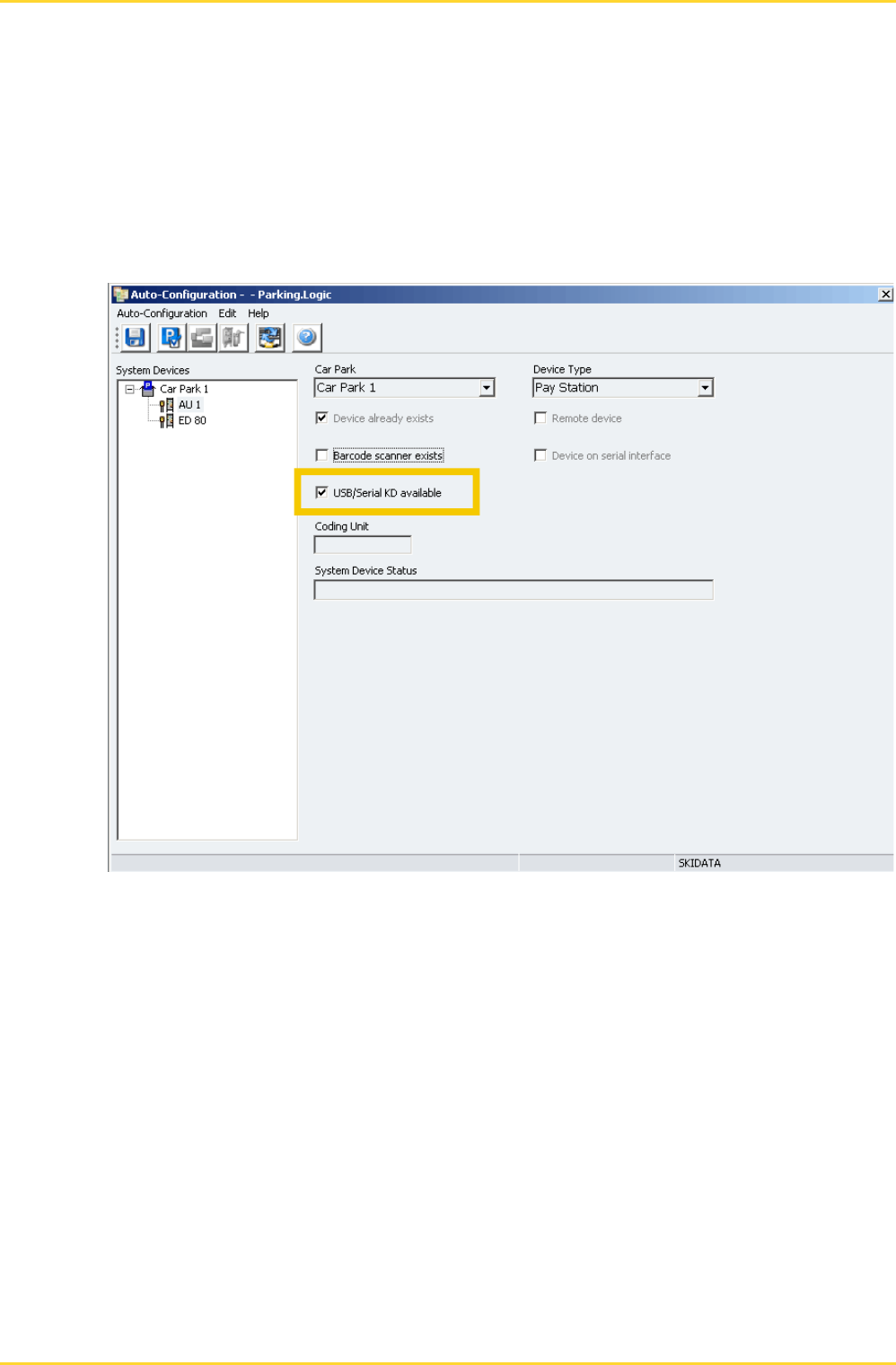
5 Integration into the system ('desk’ version) Keydetector.Gate ‘wall/desk’ - CA
Page 17 © SKIDATA AG, Instructions for Installation V1.1
5 Integration into the system ('desk’ version)
Install the USB drivers
(Release DVD: \Deploy\$OEM$\$1\Drivers\Ports\SDVCP\TicketReaderFamilyInstaller.exe)
Select the USB/Serial KD available option
(Main Menu>Automatic Configuration>System Devices)
Fig
. 8: Selecting checkbox

Keydetector.Gate ‘wall/desk’ - CA 6 Door- / Gate Opener
© SKIDATA AG, Instructions for Installation V1.1 Page 18
6 Door- / Gate Opener
The Door- / Gate Opener allows for the automatic opening of doors and shutter gates by way of
contactless reading of a keycard or Swatch Access watch (issued e.g. to contract parkers).
When using magnetic strip cards or barcode cards, a six-digit access code (printed on the card —
see below) must be entered into the keypad of the Door- / Gate Opener.
The access code of system-based cards (tickets) contains part of the facility number and a
checksum (except for short-term tickets, which carry a serial number). The access code for credit
card and ec-card holders consists of the last six digits of the card or account number.
The Door- / Gate Opener provides a cost-effective alternative to the Parking Column as an access
control device for car park sections restricted to holders of contactless contract parking permits
(keycard or Swatch Access).
Data transfer between the Door- / Gate Opener and the Administration Unit is effected by way of an
sd448 serial interface converter. A separate control process is run for each Door- / Gate Opener
(e.g. at the Admin Unit or a process computer).
The type and scope of the card verification process depends on the data carrier used.
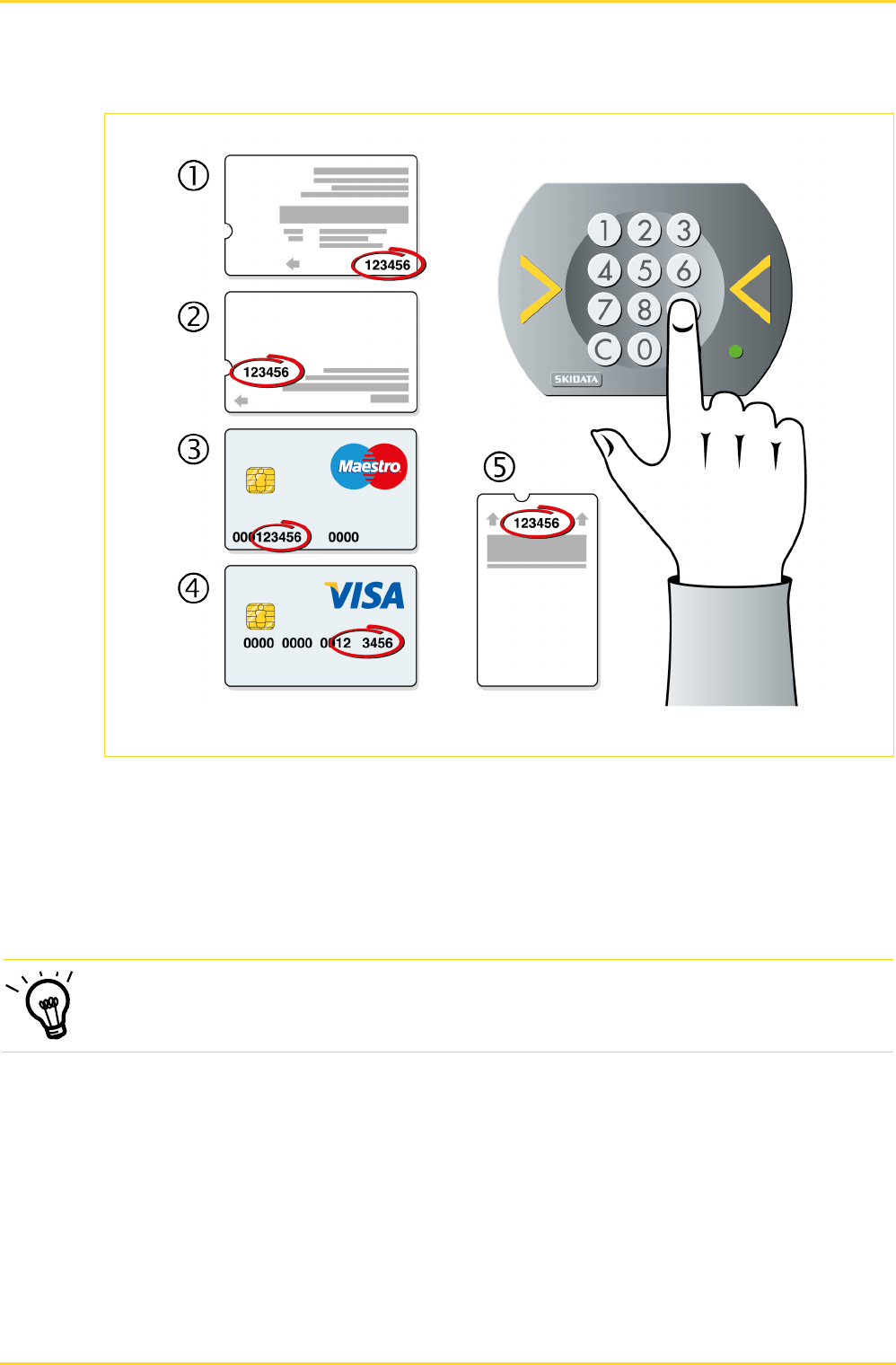
6 Door- / Gate Opener Keydetector.Gate ‘wall/desk’ - CA
Page 19 © SKIDATA AG, Instructions for Installation V1.1
Fig.
9: Access Codes
Short-term parking ticket (lengthwise
barcode)
(Short-term) parking ticket with magnetic
stripe
Ec-card
Credit Card
Short-term parking ticket (crosswise
barcode)
Tipp:
The schematic above is available as an adhesive (stick-on) pictogram (12 cm x13 cm).
If only crosswise barcode tickets (5) and RFID tickets are used, the left section
(1
-4) may be cut off.

Keydetector.Gate ‘wall/desk’ - CA 6 Door- / Gate Opener
© SKIDATA AG, Instructions for Installation V1.1 Page 20
6.1 Card Verification Procedure of the Door Opener
6.1.1 Contactless Parking Products (keycard, Swatch Access)
Normal Operation
Article Allowed
Card Validity
Time Window
Transaction
Card Blocked (i.e. access authorizations revoked)
Emergency Mode (if network connection between Administration Unit and Door- / Gate Opener is
interrupted):
Any readable contactless parking product is accepted.
6.1.2 Magnetic Strip Cards and Barcode Cards with Access Code
Normal Operation
Personnel No.
Checksum
Facility No. (Access is also granted to holders of cards issued at permitted extraneous facilities.)
Emergency Mode
Any 6-digit code is accepted
6.2 Card Verification Procedure of the Door Opener
6.2.1 Contactless Parking Products (keycard, Swatch Access)
Normal Operation
Article allowed
Card blocked
Valid from
Entrance Column, Pay Station or Automatic Payment Machine in Emergency Mode
Door Opener in Neutral Mode (until 72 hours after activation of Neutral Mode)
Presence
Emergency Mode
Any readable contactless parking product is accepted.

6 Door- / Gate Opener Keydetector.Gate ‘wall/desk’ - CA
Page 21 © SKIDATA AG, Instructions for Installation V1.1
6.2.2 Magnetic Strip Cards and Barcode Cards with Access Code
Normal Operation
Personnel Card
Is card blocked
Is Card an Emergency Mode Ticket
Presence
If Entrance Column, Pay Station or Automatic Payment Machine is in Emergency Mode or Door
Opener is in Neutral Mode (until 72 hours after activation of Neutral Mode) verify includes:
― Checksum and
― Facility No. (2 digits – Access is also granted to holders of cards issued at ‘permitted
extraneous facilities’.)
Emergency Mode
Any 6-digit code is accepted.
Emergency Mode Ticket
Access codes assigned to short-term tickets during emergency operation will be accepted after
normal operation is resumed, and also after the vehicle has exited the car park.
6.3 Operational States
6.3.1 IDLE State (Door Opener Only)
The Presence Detection Loop is not vaporized; neither Keep Open nor Keep Closed is activated
(via Control Centre); the LED is ORANGE; the Door- / Gate Opener is inactive.
6.3.2 Normal State
Gate Opener: The Presence Detection Loop is vaporized; neither Keep Open nor Keep Closed is
activated (via Control Centre); the LED is flashing, its color alternating between GREEN and
ORANGE.
Door Opener: The Presence Detection Loop input must remain in vaporized state (this can be
effected by means of a wire link).
Keyboard an BLL-unit are activated; the LED is flashing, its color alternating between GREEN and
ORANGE.
6.3.3 Out of Order
The unit has been deactivated (either manually via the Control Centre (Keep Closed) or
automatically as the result of a fault); the keyboard and Contactless Reader unit are deactivated;
the LED is RED.
Synchronization commands transmitted from the Administration Unit (Control Centre, system
maintenance programs) are accepted.

Keydetector.Gate ‘wall/desk’ - CA 6 Door- / Gate Opener
© SKIDATA AG, Instructions for Installation V1.1 Page 22
6.4 Keypad
When the keypad is activated, a brief beep (click) is sounded every time a key is pressed.
Following the input of six consecutive digits, a beep lasting approximately one second is emitted to
signal the completion of the code input. The code entered is then processed and the keypad buffer
cleared.
If the delay between the input of the individual digits exceeds five seconds, the keypad buffer is
cleared automatically, requiring the input procedure to be restarted. Users can also cancel their
input by pressing the C or E key.
6.5 Data Exchange with Control Centre Program (CTC)
6.5.1 Door- / Gate Opener
When the Open command is issued, the Door- / Gate Opener output terminal is activated for a pre-
defined period (this can be adjusted via the Device Settings program).
The LED lights up GREEN for three seconds, and a short beep is emitted. The unit then returns to
Normal State.
6.5.2 Keep Open
The Door- / Gate Opener output terminal is permanently activated. The LED lights up GREEN. This
state can be deactivated via the Keep Open OFF command.
6.5.3 Keep Closed
The system behavior is the same as when set to Out of Order.
6.5.4 Transaction NEUTRAL
Gate Opener: The gate opens even if the previous transaction with a contactless parking product
was unsuccessful (e.g. if a card is used to gain access although it is already registered as being
present).
Door Opener: Access is granted even if the card used is not registered as being present.
6.5.5 Display of Reason for Rejection
Shows a list of unsuccessful access attempts and the respective reasons why access was denied
(e.g. Incorrect code entered, Card read error, Card not registered as present, etc). The list can be
viewed via the Control Centre program of the Administration Unit.

6 Door- / Gate Opener Keydetector.Gate ‘wall/desk’ - CA
Page 23 © SKIDATA AG, Instructions for Installation V1.1